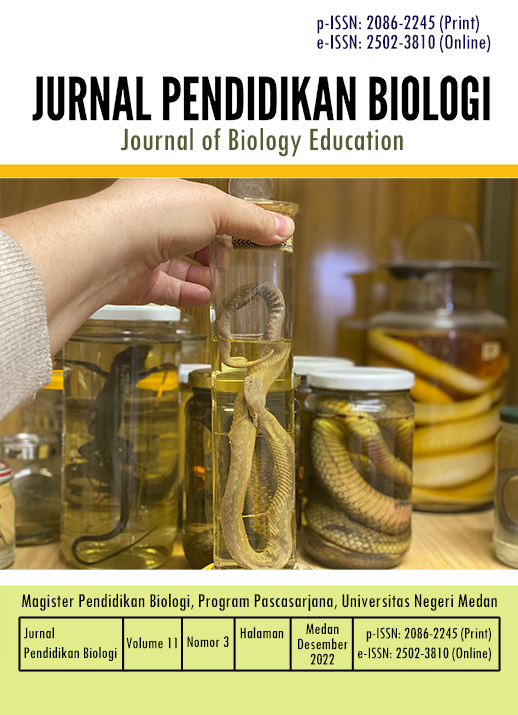Development Of Lichens Nontext Book As A Research-Based Bioindicator Of Air Pollution In Medan City
DOI:
https://doi.org/10.24114/jpb.v11i3.22606Keywords:
Bioindicators, Development, Lichens, Non-Textbooks, Research.Abstract
There are very few books of Lichens as a bioindicator of air pollution in the city of Medan, so the purpose of this study is to develop a non-textbook about Lichens as a research-based bioindicator of air pollution in the city of Medan. This type of research used Research and Development 4D Thiagarajan. The method used in this research is the book feasibility test, N-Gain, and t-test. The validated book results are 88% (material aspect is very feasible), 82% (language aspect is very feasible category) and 83% (graphic aspect is very feasible category). The results of the product trial showed that the test results obtained were 87% (the individual aspect was in the very feasible category), 82% (the small group was in the very feasible category) and 85% (the limited group was very feasible category). The non-text book was then tested for the effectiveness of its use on 28 students, it was obtained 0.84 with a percentage of 80% (effective) and the general public as many as 25 high school teachers, it obtained 0.93 with a percentage of 93% (effective). The t-test results obtained tcount> ttable, namely, 9.096> 1.703 for the cognitive abilities of students majoring in Biology at the State University of Medan, and the ttest results obtained tcount> ttable namely, 8.345> 1.729 for general public cognitive, it can be concluded that the results of the t-test are obtained significantly, and non-text books have an effect on improving cognitive abilities of students and the general public, with α = 0.05.References
Basuki, S. (1994). Pengantar Ilmu Perpustakaan. Gramedia Pustaka Utama, Jakarta.
Campbell, N, A., Reece, J, B. (2010). Biologi Edisi Kedelapan Jilid 3. Erlangga, Jakarta.
Hake, R, R. (1998). Promoting student crossover to the Newtonian world, American Journal of Physics, 55(10), 878-884. https://doi.org/10.1119/1.14945.
Martin, P. (2012). Pengembangan Bahan Ajar Science Entrepreneurship Berbasis Hasil Penelitian untuk Mendukung Program Kreatifitas Mahasiswa, Jurnal Penelitian Pendidikan, 2(29), 101-108.
Prasetyo, E. (2015). Ternyata Penelitian Itu Mudah (Panduan Melaksanakan Penelitian Bidang Pendidikan), Cet. 1. Penerbit Edunomi.
Puskurbuk. (2008). Pedoman Penilaian Buku Nonteks Pelajaran, Kementerian Pendidikan dan Kebudayaan, Jakarta.
Ristekdikti. (2012). Penilaian Buku Nonteks Pelajaran, Erlangga, Jakarta.
Sofyan, N. (2017). Keanekaragaman Lichens sebagai Bioindikator Kualitas Udara di Kawasan Industri Citeureup dan Hutan Penelitian Dramaga, IPB, Institut Pertanian Bogor.
Susilawati, P, R. (2013). Keanekaragaman Corticolous Lichen dan Preferensi Inangnya dengan Erythrina lithosperma Miq., Pinus merkisii Jungh. & De Vr. Dan Engelhardtia spicta Blume Di Bukit Bibi, Taman Nasional Gunung Merapi, Universitas Gadjah Mada (UGM), Yogyakarta.
Sugiyono. (2015). Metode Penelitian Kombinasi (Mix Methods), Alfabeta, Bandung.
Sugiyono., (2019). Metode Penelitian dan Pengembangan Research and Development, Alfabeta, Bandung. (book)
Tjitrosoepomo, G. (2011). Taksonomi Tumbuhan Tingkat Rendah, Gadjah Mada University Press, Yogyakarta.
Widyaningrum, E., Aprilya, S., & Iqbal, M. (2015). Pengembangan Produk Penelitian Berupa Buku Nonteks sebagai Buku Pengayaan Pengetahuan (The Developing of Research Product in the Form Non-Textbook as a Knowledge Enrichment Book), Artikel Ilmiah Mahasiswa, 1(1), 1-5.
Downloads
Published
Issue
Section
License
Copyright (c) 2022 Jurnal Pendidikan Biologi

This work is licensed under a Creative Commons Attribution 4.0 International License.
Copyright
Penyerahan naskah menyiratkan bahwa karya yang diserahkan belum pernah diterbitkan sebelumnya (kecuali sebagai bagian dari tesis, laporan, atau abstrak). Naskah tidak dipertimbangkan untuk publikasi di tempat lain. Penerbitannya telah disetujui oleh semua penulis bersama. Jika dan kapan naskah diterima untuk publikasi, penulis masih memegang hak cipta dan mempertahankan hak penerbitan tanpa batasan. Penulis atau orang lain diperbolehkan untuk melipatgandakan artikel selama tidak untuk tujuan komersial. Untuk penemuan baru, penulis disarankan untuk mengelola patennya sebelum diterbitkan.
Open Access
Jurnal ini berkomitmen untuk membuka akses bebas yang tidak membebankan biaya kepada pembacanya atau lembaga mereka. Pembaca berhak membaca, mengunduh, menyalin, mendistribusikan, mencetak, mencari, atau menautkan ke teks lengkap artikel, selama tidak untuk tujuan komersial. Jenis lisensi adalah CC-BY-4.0.
Disclaimer
Tidak ada tanggung jawab yang dikenakan kepada Penerbit atau oleh editor untuk kesalahan dan/atau kerusakan pada naskah sebagai akibat dari pernyataan pencemaran nama baik atau dugaan pencemaran nama baik, pelanggaran hak kekayaan intelektual atau privasi, atau kewajiban produk, baik akibat kelalaian atau sebaliknya, atau dari penggunaan atau operasi ide, instruksi, prosedur, produk atau metode apa pun yang terkandung dalam materi di dalamnya.

